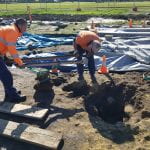Only one day of excavation this week – we’re incredibly important and busy people. Despite the short week, we’ve still had a few interesting things pop up.
In my square, I’ve finally said goodbye to the layers of dolerite yard surfacing. In the end, there were six separate layers of gravel all smooshed together in about a 10cm horizon. That took a while to unravel. However, it appears to have been worth it, as under all this we have a new type of surface – dolerite cobbling! Oh my! Formed from rounded and subangular stones, likely fieldstone collected from the area, these cobbles have been set into a redeposited doleritic clay (the orange layer). A bit of broken dolerite has been used as a surface adjacent. I currently have no idea what this was used for. Definitely a surface, but was it an internal surface within a building? An external yard surface? A path? A working surface? Whatever, it’s really early – like 1830s early. It has been cut by the later ’round thing’ and covered by gravel from at least the 1850s. It could be associated with the 1835-36 workshops. Alternatively, it could predate them – which makes them one of the earliest bits of convict period architecture I have seen on the site. Needless to say, I am pretty excited by this. Next week I’ll start work on the squares around it to expose it more fully.
For once, Sylvana’s trench has not been the most exciting. Not that it’s a competition or anything. She spent the day recording the section. As we expected, the level of water in the trench has increased, the tide percolating through the sandstone reclamation. This confirms that the log was likely part of the 1830s waterfront infrastructure.




